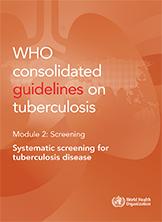2.7.1 Summary of evidence and rationale
Several clinical characteristics, conditions and comorbidities can indicate an increased risk for developing TB disease or suffering worse outcomes from the disease, or both. Individuals identified as having untreated fibrotic lesions on CXR and who are not diagnosed with TB disease are at increased risk of developing TB disease (34–37). These individuals are often identified through TB screening or clinical evaluation or during a clinical evaluation done for other reasons.

 Feedback
Feedback